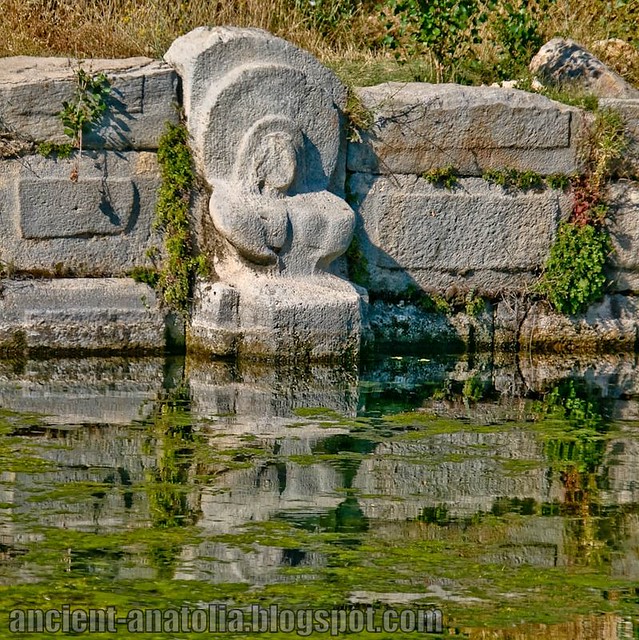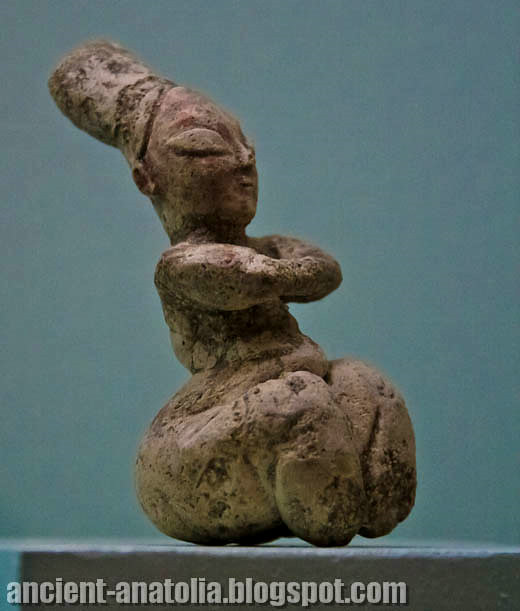
Originally a Hittite and Phrygian goddess, Cybele was a deification of the Earth Mother and was worshipped in Anatolia since Neolithic times. As with Gaia (the "Earth") or her Minoan equivalent Rhea, Cybele embodies the fertile Earth, a goddess of caverns and mountains, walls and fortresses, nature, wild animals (especially lions and bees).

Her Ancient Greek title, Potnia Theron, also associated with the Minoan Great Mother, alludes to her Neolithic roots as the "Mistress of the Animals". She becomes a life-death-rebirth deity in connection with her resurrection of her son and consort, Attis. She is associated with her lion throne and her chariot drawn by lions.
In Roman, her equivalent was Magna Mater or "Great Mother". Walter Burkert, who treats Meter among "foreign gods" in Greek Religion described the evolution of the cult as follows: "The cult of the Great Mother, Meter, presents a complex picture insofar as indigenous, Minoan-Mycenean tradition is here intertwined with a cult taken over directly from the Phrygian kingdom of Asia Minor".
 Ancient Greeks considered "Cybele" to be Greek, the traditional derivation of her name, as "she of the hair" can be ignored, now that the inscription of one of her Phrygian rock-cut monuments has been read matar kubileya. The inscription matar occurs frequently in her Phrygian sites (Burkert). Kubileya is usually read as a Phrygian adjective "of the mountain", so that the inscription may be read Mother of the Mountain, and this is supported by Classical sources. Another theory is that her name can be traced to the Luwian Kubaba, the deified queen of the Third Dynasty of Kish worshiped at Carchemish and Hellenized to Kybebe. With or without the etymological connection, Kubaba and Matar certainly merged in at least some aspects, as the genital mutilation later connected with Cybele's cult is associated with Kybebe in earlier texts, but in general she seems to have been more a collection of similar tutelary goddesses associated with specific Anatolian mountains or other localities, and called simply "mother" (Motz).
Ancient Greeks considered "Cybele" to be Greek, the traditional derivation of her name, as "she of the hair" can be ignored, now that the inscription of one of her Phrygian rock-cut monuments has been read matar kubileya. The inscription matar occurs frequently in her Phrygian sites (Burkert). Kubileya is usually read as a Phrygian adjective "of the mountain", so that the inscription may be read Mother of the Mountain, and this is supported by Classical sources. Another theory is that her name can be traced to the Luwian Kubaba, the deified queen of the Third Dynasty of Kish worshiped at Carchemish and Hellenized to Kybebe. With or without the etymological connection, Kubaba and Matar certainly merged in at least some aspects, as the genital mutilation later connected with Cybele's cult is associated with Kybebe in earlier texts, but in general she seems to have been more a collection of similar tutelary goddesses associated with specific Anatolian mountains or other localities, and called simply "mother" (Motz).The goddess was known among the Greeks as Meter or Meter oreie ("Mountain-Mother"), or, with a particular Anatolian sacred mountain in mind, Idaea, inasmuch as she was supposed to have been born on Mount Ida in Anatolia, or equally Dindymene or Sipylene, with her sacred mountains Mount Dindymon (in Mysia and variously located) or Mount Sipylus in mind.
Athenian Cybele seated on her throne with a tymbalon, (4th century BCE, Athens)Other followers of Cybele, the Phrygian kurbantes or Corybantes, expressed her ecstatic and orgiastic cult in music, especially drumming, clashing of shields and spears, dancing, singing, and shouting—all at night.
Cult history
Her cult moved from Phrygia to Greece from the 6th to the 4th century BCE. In 203 BCE, Rome adopted her cult as well.
Anatolia and Greece
Greek mythographers recalled that Broteas, the son of Tantalus, was the first to carve the Great Mother's image into a rock-face. At the time of Pausanias (2nd century CE), a sculpture carved into the rock-face of a spur of Spil Mount was still held sacred by the Magnesians.
At Pessinos in Phrygia, an archaic image of Cybele had been venerated as well as the cult of Agdistis, in 203 BCE its aniconic cult object was removed to Rome.
Her cult had already been adopted in 5th century BCE Greece, where she is often referred to euphemistically as Meter Theon Idaia ("Mother of the Gods, from Mount Ida") rather than by name. Mentions of Cybele's worship are found in Pindar and Euripides, among other locations.
Cybele's cult in Greece was closely associated with, and apparently resembled, the later cult of Dionysus, whom Cybele is said to have initiated and cured of Hera's madness. They also identified Cybele with the Mother of the Gods Rhea.
Anatolian Cybele

Various aspects of Cybele's Anatolian attributes probably predate the Bronze Age in origin.
A figurine found at Çatalhöyük, (Archaeological Museum, Ankara), dating about 6000 BCE, depicts a corpulent and fertile Mother Goddess in the process of giving birth while seated on her throne, which has two hand rests in the form of lion's heads. No direct connection with the later matar goddesses is documented, but the similarity to some of the later iconography is striking.
By the 2nd millennium BCE the Kubaba of Bronze Age Carchemish was known to the Hittites and Hurrians: "[O]n the basis of inscriptional and iconographical evidence it is possible to trace the diffusion of her cult in the early Iron Age; the cult reached the Phrygians in inner Anatolia, where it took on special significance" (Burkert, III.3.4, p. 177). If the theory on the Luwian origin of Cybele's name is correct, Kubaba must have merged with the various matar goddesses well before time the Phrygian matar kubileya inscription was made around the first half of the 6th century BCE(Vassileva 2001).
In Phrygia Rhea-Cybele was venerated as Agdistis, with a temple at the great trading city Pessinos, mentioned by the geographer Strabo. It was at Pessinos that her lover Attis (son of Nana) was about to wed the daughter of the king, when Agdistis-Cybele appeared in her awesome glory, and he castrated himself.
In Archaic Phrygian images of Cybele of the sixth century, already betraying the influence of Greek style (Burkert), her typical representation is in the figuration of a building’s façade, standing in the doorway. The façade itself can be related to the rock-cut monuments of the highlands of Phrygia. She is wearing a belted long dress, a polos (high cylindrical hat), and a veil covering the whole body. In Phrygia, her usual attributes are the bird of prey and a small vase. Sometimes lions are related to her in an aggressive, but tamed, manner. Often the lions are shown drawing her chariot, which may be related as the sun traversing the sky daily.
Later, under Hellenic influence along the coastal lands of Asia Minor, the sculptor Agoracritos, a pupil of Pheidias, produced a version of Cybele that became the standard one. It showed her still seated on a throne but now more decorous and matronly, her hand resting on the neck of a perfectly still lion and the other hand holding the circular frame drum, similar to a tambourine, (tymbalon or tympanon), which evokes the full moon in its shape and is covered with the hide of the sacred lunar bull.
Hannahannah (from Hittite hanna- "grandmother", anne/ana: mother, anneanne: grandmother in Turkish) is a Hurrian Mother Goddess related to or influenced by the pre-Sumerian goddess Inanna. Hannahannah was also identified with the Hurrian goddess Hebat.
Cybele and Attis
The goddess appears alone, 8th–6th centuries BCE. Later she is joined by her son and consort Attis, who incurred her jealousy. He, in an ecstasy, castrated himself, and subsequently died. Grieving, Cybele resurrected him. This tale is told by Catullus in one of the long poems of his Carmina ( Poems ) —number 63. The evergreen pine and ivy were sacred to Attis.
Some ecstatic followers of Cybele, known in Rome as galli, willingly castrated themselves in imitation of Attis. For Roman devotees of Cybele Mater Magna who were not prepared to go so far, the testicles of a bull, one of the Great Mother's sacred animals, were an acceptable substitute, as many inscriptions show. An inscription of 160 CE records that a certain Carpus had transported a bull's testes from Rome to Cybele's shrine at Lyon, France.
Aegean Cybele
The worship of Cybele spread from inland areas of Anatolia and Syria to the Aegean coast, to Crete and other Aegean islands, and to mainland Greece. She was particularly welcomed at Athens. The geographer Strabo (book x, 3:18) made some useful observations:
"Just as in all other respects the Athenians continue to be hospitable to things foreign, so also in their worship of the gods; for they welcomed so many of the foreign rites ... the Phrygian [rites of Rhea-Cybele are mentioned] by Demosthenes, when he casts the reproach upon Aeskhines' mother and Aeskhines himself, that he was with her when she conducted initiations, that he joined her in leading the Dionysiac march, and that many a time he cried out evoe saboe, and hyes attes, attes hyes; for these words are in the ritual of Sabazios and the Mother [Rhea]."
In Ancient Egypt at Alexandria, Cybele was worshiped by the Greek population as "The Mother of the Gods, the Savior who Hears our Prayers" and as "The Mother of the Gods, the Accessible One". Ephesus, one of the major trading centers of the area, was devoted to Cybele as early the 10th century BCE, and the city's ecstatic celebration, the Ephesia, honored her.
The goddess was not welcome among the Scythians north of Thrace. From Herodotus (4.76-7) we learn that the Scythian Anacharsis (6th century BCE), after traveling among the Greeks and acquiring vast knowledge, was put to death by his fellow Scythians for attempting to introduce the foreign cult of Magna Mater.
Roman Cybele
According to Livy in 10 CE, an archaic version of Cybele, from Pessinos in Phrygia, as mentioned above, that embodied the Great Mother was ceremoniously and reverently moved to Rome, marking the official beginning of her cult there. Rome was embroiled in the Second Punic War at the time (218 to 201 BCE). An inspection had been made of the Sibylline Books and some oracular verses had been discovered that announced that if a foreign foe should carry war into Italy, that foe could be driven out and conquered if the Mater Magna were brought from Pessinos to Rome. Publius Cornelius Scipio Nasica was ordered to go to the port of Ostia, accompanied by all the matrons, to meet the goddess. He was to receive her image as she left the vessel, and when brought to land he was to place her in the hands of the matrons who were to bear her to her destination, the Temple of Victory on the Palatine Hill. The day on which this event took place, 12 April, was observed afterwards as a festival, the Megalesian.
Plutarch relates that in 103 BCE, Battakes, a high priest of Cybele, journeyed to Rome to announce a prediction of Gaius Marius's victory over the Cimbri and Teutoni. A. Pompeius, plebeian tribune, together with a band of ruffians, chased Battakes off of the Rostra. Pompeius supposedly died of a fever a few days later.
Under the emperor Augustus, Cybele enjoyed great prominence thanks to her inclusion in Augustan ideology. Augustus restored Cybele's temple, which was located next to his own palace on the Palatine Hill. On the cuirass of the Prima Porta of Augustus, the tympanon of Cybele lies at the feet of the goddess Tellus. Livia, the wife of Augustus, ordered cameo-cutters to portray Cybele with her likeness. The Malibu statue of Cybele bears the visage of Livia.
In Roman mythology, Cybele was given the name Magna Mater deorum Idaea ("great Idaean mother of the gods"), in recognition of her Phrygian origins (although this title was given to Rhea also).
Roman devotion to Cybele ran deeply. Not coincidentally, when a Christian basilica was built over the site of a temple to Cybele to occupy the site, the sanctuary was rededicated to the Mother of God, as the Basilica di Santa Maria Maggiore. However, later, Roman citizens were forbidden to become priestesses of Cybele, who were eunuchs like those of their Asiatic Goddess.
The worship of Cybele was exported to the empire, even as far away as Mauretania, where, just outside Setif, the ceremonial "tree-bearers" and the faithful (religiosi) restored the temple of Cybele and Attis after a disastrous fire in 288 CE. Lavish new fittings paid for by the private group included the silver statue of Cybele and the chariot that carried her in procession received a new canopy with tassels in the form of fir cones. (Robin Lane Fox, Pagans and Christians, p 581.) The popularity of the Cybele cult in the city of Rome and throughout the empire is thought to have inspired the author of Book of Revelation to allude to her in his portrayal of the mother of harlots who rides the Beast. Cybele drew ire from Christians throughout the Empire; famously, St. Theodore of Amasea is said to have spent the time granted to him to recant his beliefs, burning a temple of Cybele instead.
Today, a modern monumental statue of Cybele can be found in one of the principal traffic circles of Madrid, the Plaza de Cibeles.
In Roman poetry
In Rome, her Phrygian origins were recalled by Catullus, whose famous poem ( number 63 ) on the theme of Attis includes a vivid description of Cybele's worship: "Together come and follow to the Phrygian home of Cybele, to the Phrygian forests of the goddess, where the clash of cymbals ring, where tambourines resound, where the Phrygian flute-player blows deeply on his curved reed, where ivy-crowned maenads toss their heads wildly."
In the second book of his De rerum natura, Lucretius appropriately uses the image of Cybele, the Great Mother, as a metaphor for the Earth. His description of the followers of the goddess is thought to be based on autopsy of the celebration of her cult in Rome.
Cybele in the Aeneid
In his Aeneid, which was written in the first century BCE (between 29 and 19 BCE), Virgil called her, Berecyntian Cybele, alluding to her place of origin. He described her as the mother of the gods.
In his late version of the legendary story, the Trojans are in Italy and have kept themselves safe in a walled city, following Aeneas's orders. The leader of the Rutuli, Turnus, then ordered his men to burn the ships of the Trojans. At this point in the new legend, there is a flashback to Mount Olympos years before the Trojan War: after Cybele had given her sacred trees to the Trojans so that they could build their ships, she went to Zeus and begged him to make the ships indestructible; Zeus granted her request by saying that when the ships had finally fulfilled their purpose (bringing Aeneas and his army to Italy) they would be turned into sea nymphs rather than be destroyed; so, as Turnus approached with fire, the ships came to life, dove beneath the sea, and emerged as nymphs.
Of course, Cybele was a powerful goddess who had existed long before the "birth" of Zeus, and she would have been worshipped in that area from antiquity, so this new legend may contain elements of much older myths that have been lost—such as the trees that turned into sea nymphs.